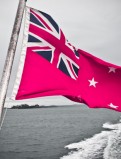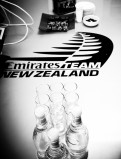Zero Moments of Uncertainty
Try ordering something online and have it delivered to your home address. I dare you to. At least in Australia.
You’ll be confronted by one of the most common zero moments of uncertainty – “when will my package arrive, how will I possibly take delivery of it”.
It’s likely you’ll might not benefit from the convenience of home delivery in Australia. Instead, after a series of frustrating notifications you’ll be forced to drive to a pick-up center, or worse, a Post Office. This only gets worse as more and more businesses shut down the opportunity for the employee to have products delivered at work (they’ve got a point as small delivery bays designed for mail get filled with boxes packed with everything from undies to wine and surfboards.
The very name the companies serving us go by underscores the basic problem we all face – they are logistics companies. Or something like that. They serve the sender not the receiver even though it is us paying for their services (for the most part). I doubt many of them have ever looked at the challenge of delivery through the lens of the receiver. And the company doing the sending lets their focus slide once the package leaves their despatch bay.
So, rather than randomly appearing on our doorstep only to be confronted by an absent recipient shippers could solve this most basic issue using, dare I say it, email. Or an app. Even a text message. This is a simple service design gap – an assumption on their part and source of uncertainty and dissatisfaction on ours.
Simply put, ask us if we are home electronically, invite us to select a time for delivery, or, even change the delivery address. eCommerce will grow. More satisfied and trusting customers will result. And massive fuel and labor savings for carriers will abound. So simple.
All they need to do is embrace service design and the need to satisfy my customer’s customer.
Making the Campaign Social
For so many advertising campaigns social is merely a bolt-on. An amplifier added at the last minute to improve reach.
TD Ameritrade’s latest Olympic campaign looks to have done it right, integrating social into the fabric of the campaign.
In what the brand is calling a first, it also is sending seven athletes, aged 14 to 21, to the Winter Games in Sochi, Russia in February, who are not competing but hope to qualify for the Winter Olympics in 2018. These next-generation athletes, as the brand refers to them, compete in the same sports as the sponsored Olympic athletes, who will act as their mentors.
TD Ameritrade set up brokerage accounts for these next-generation athletes, and once they arrive in Russia, every time consumers use the hashtag #itaddsup, the company will add $1 to a fund that will be split equally in their accounts, with each receiving a total of as much as $25,000.
The Seat In Front
Flying for three hours from Melbourne to Auckland with the seat that is meant to be in front of you in your lap is frustrating. When the guy in the middle seat decides to revolt by spreading out as much as he can – all while you’ve got a minimum of three hours work to get done is maddening. So went my last trip with Qantas.
Now, these aren’t cheap tickets but these are the cheapest of seats. Qantas is sufferning from the same brand malaise most airlines are. Their brand is entirely inconsistent with their service promise. In an age of new planes, lay flat beds, and laptop friendly leg-room, most are still flying ageing birds sized well for hobbits, but less so for humans.
Their advertising showing the very best they have to offer sets the bar so high above what they actually do offer for the most part, that you are left wondering how you ever bought the promise. Stupid is as stupid does.
There are plenty of solutions. Parked next to the Qantas “mini” packed to the hilt with wary travelers sat a cavernous Emirates Airbus – flying to the same place. Why not code-share more agressively – wasn’t that the point of the partnership?
This happens too often. What is needed is more transparency into the level and gade of service offered. Perhaps a Gold, Silver, Brown rating system so that we can all clearly comprehend what we are buying? Or, perhaps this is better solved by an iPhone app from an independent third party? How about a “not work or business friendly” caution before you book or get on the plane.
Either way, the airline industry needs to embrace transparency and close the gap between it’s presented brand and service delivered.
Back on Air New Zealand today the leg room was good enough to allow me three hours of solid work, and the service friendly. Gettting the basics right and delivering on the brand promise isn’t so hard.
WARC Prize for Social Strategy
I’ve enjoyed using WARC for a few years now so am thrilled to be judging their global social media strategy prize. Hopefully this will result not only in a worthy winner but a bevvy of brilliant case studies. There is a great crew of judges for this one.
The Worst Mascot Ever
Yep, here you have it. Fukuppy.
A mascot for Fukushima Industries, a manufacturer of refrigerators. Like all good mascot’s this one has responsibilities… like, “I fly around on my awesome wings, patrolling supermarket showcases and kitchen refrigerators. I can talk to vegetables, fruit, meat, and fish and can check on their health!”






